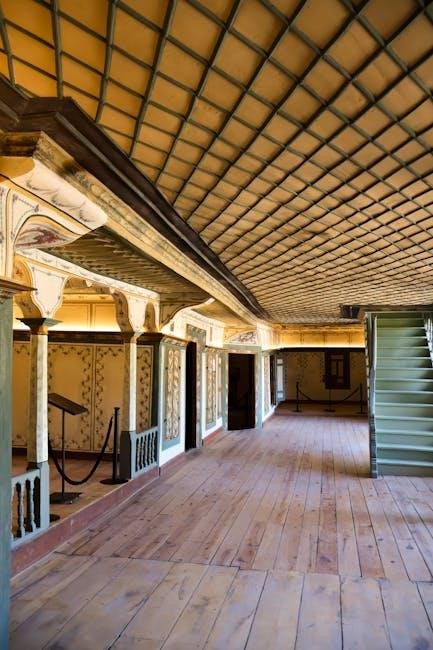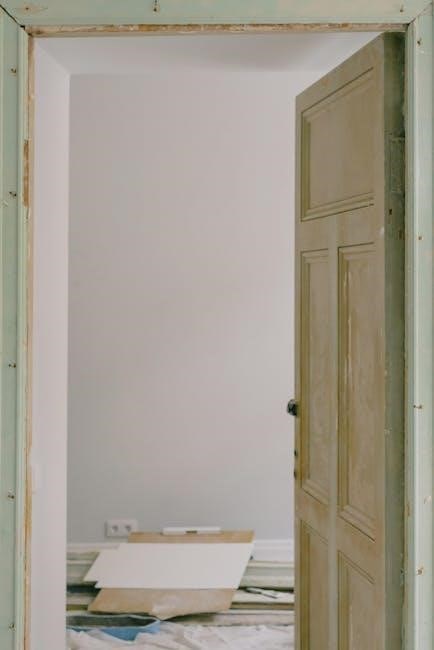A detailed cost estimate for house construction provides a comprehensive breakdown of all expenses involved in building a residential property. It ensures accurate budgeting and planning, helping homeowners and contractors anticipate costs effectively. This estimate covers materials, labor, equipment, and contingencies, offering a clear financial roadmap for the project. It is essential for decision-making and project management, ensuring transparency and minimizing cost overruns.
1.1 Importance of a Detailed Cost Estimate
A detailed cost estimate is crucial for ensuring accurate budgeting and avoiding cost overruns in house construction. It provides a clear understanding of all financial aspects, helping homeowners and contractors make informed decisions. By breaking down material, labor, and equipment costs, it enhances transparency and accountability. A well-prepared estimate also aids in risk management by identifying potential contingencies. This ensures the project stays within budget and aligns with the client’s expectations, making it an essential tool for successful project planning and execution. Proper cost estimation also builds trust between all parties involved.
1.2 Purpose of a Detailed Cost Estimate in Construction
The primary purpose of a detailed cost estimate in construction is to provide a precise financial overview of the project. It helps in allocating resources efficiently and ensures that all stakeholders are aligned on the budget. This estimate serves as a baseline for monitoring expenses and making adjustments as needed. It also facilitates better negotiation with suppliers and contractors, ensuring cost-effectiveness. By outlining each cost component, it supports long-term financial planning and helps in securing funding or approvals for the project. This makes it indispensable for successful project execution and management.

Methods of Estimating Construction Costs
Accurate cost estimation is crucial for construction projects. Common methods include the Quantity Survey Method, which calculates material and labor costs based on detailed measurements, and the Unit Pricing Method, which estimates costs per unit of work. These approaches ensure transparency and help in allocating resources efficiently, providing a reliable financial framework for the project.
2.1 Quantity Survey Method
The Quantity Survey Method involves detailed measurements of materials and labor required for each component of the project. It breaks down the construction into individual items, such as bricks, cement, and steel, and calculates their quantities. Costs are then estimated using standard rates for materials and labor. This method is highly accurate and widely used in construction projects, especially for large-scale developments. It ensures transparency and helps in identifying potential cost-saving opportunities, making it a reliable approach for detailed cost estimation.
2.2 Unit Pricing Method
The Unit Pricing Method calculates costs by determining the price per unit of measurement for each material or service. For example, cost per square meter for flooring or per cubic meter for concrete. This method is efficient for projects with repetitive elements, as it simplifies cost estimation by multiplying unit rates by quantities. It offers flexibility and accuracy, especially when materials or labor rates are known in advance. This approach is commonly used in construction for its simplicity and adaptability to various project scales.
Detailed Cost Breakdown for House Construction
A detailed cost breakdown for house construction outlines expenses across materials, labor, equipment, and contingencies. It provides transparency and aids in precise financial planning and budget allocation.
3.1 Material Costs
Material costs are a significant component of house construction, encompassing expenses for cement, steel, lumber, roofing materials, electrical and plumbing fixtures, and finishes. These costs vary based on the quality, quantity, and location-specific availability of materials. Detailed estimates often include itemized lists of required materials, their quantities, and respective prices. Accurate material cost calculation ensures budget adherence and helps avoid cost overruns. Regional cost indices may also influence material prices, necessitating adjustments for precise estimation; Contingency funds are often allocated to cover unforeseen material cost fluctuations.
3.2 Labor Costs
Labor costs are a critical component of house construction, accounting for a significant portion of the total budget. These costs are calculated based on the number of workers, their skill levels, and the time required to complete each task. Labor rates vary by location, with urban areas often having higher wages due to demand. Detailed estimates break down labor costs by trade, such as carpenters, electricians, and plumbers. Contingency funds are often allocated to cover unexpected labor expenses, ensuring the project remains on track. Accurate labor cost estimation is vital for budget accuracy.
3.3 Equipment and Machinery Costs
Equipment and machinery costs encompass expenses for tools and heavy machinery used during construction. These include excavators, cranes, and concrete mixers. Rental or ownership costs, fuel, maintenance, and operator wages are considered. Detailed estimates allocate these costs to specific project phases, such as foundation work or roofing. Regional cost indices may adjust machinery rates based on location. Accurate estimation of equipment costs ensures efficient resource allocation and prevents budget overruns, making it a crucial part of the overall cost planning for house construction projects.
3.4 Contingency Costs
Contingency costs are allocations in a construction budget for unforeseen expenses. These may arise from design changes, material price fluctuations, or unexpected site conditions. Typically, contingency funds range between 5-10% of the total estimated cost. They ensure that projects can adapt to challenges without significant delays or budget overruns. Properly calculated contingency costs enhance financial flexibility and provide a safety net for contractors and homeowners, ensuring smooth project execution despite uncertainties.
Tools and Software for Creating a Detailed Cost Estimate
Construction cost calculators and estimating software are essential tools for creating detailed cost estimates. They streamline calculations, enhance accuracy, and save time in project planning and budgeting.
4.1 Construction Cost Calculators
Construction cost calculators are tools that simplify the process of estimating expenses for house building. They allow users to input specific details about materials, labor, and equipment, providing a detailed breakdown of expected costs. Many calculators are available online or as downloadable PDFs, offering pre-built templates and formulas to streamline calculations. These tools are particularly useful for homeowners and contractors to ensure accuracy and transparency in financial planning. By leveraging these calculators, stakeholders can generate comprehensive estimates tailored to their project requirements, facilitating better decision-making and budget management.
4.2 Estimating Software
Estimating software provides advanced tools for creating detailed cost estimates in construction projects. These programs often include features like cost databases, quantity calculation, and automated pricing. Software such as PlanGrid, Bluebeam, or Procore integrates with CAD designs and allows real-time collaboration. They simplify the process of breaking down materials, labor, and equipment costs, ensuring precision. Many platforms also offer customizable templates and reporting options, making it easier to generate professional PDF estimates. This technology enhances accuracy, reduces manual errors, and streamlines the estimation process for both contractors and project managers.

Templates and Examples for Detailed Cost Estimates
Downloadable PDF templates provide structured formats for organizing cost estimates, offering customizable sections for materials, labor, and equipment. These examples guide users in creating professional, detailed estimates efficiently.
5.1 PDF Templates for House Construction Estimates
PDF templates for house construction estimates provide a structured format for organizing and presenting detailed cost breakdowns. These templates often include sections for materials, labor, equipment, and contingency costs, ensuring comprehensive coverage. They are customizable to suit specific project requirements, allowing users to input quantities, rates, and descriptions. Many templates also include examples or case studies, offering practical guidance. By using PDF templates, users can streamline the estimation process, enhance accuracy, and maintain professional documentation throughout the project lifecycle.
5.2 Case Studies and Examples
Case studies and examples provide practical insights into the application of detailed cost estimation in house construction. They illustrate how materials, labor, and equipment costs are calculated for specific projects. For instance, a case study on a 400sqft house in Wayanad district demonstrates cost estimation at various construction stages, incorporating regional cost indices. These examples help users understand how to prepare accurate estimates, manage contingencies, and adapt to location-specific factors, making them invaluable for both novice and experienced estimators alike in real-world applications.

Preparing a Comprehensive Bill of Quantities
A comprehensive bill of quantities lists all materials, labor, and equipment required for the project, with precise quantities and pricing to ensure accurate cost estimation and project management.
6.1 Items Included in the Bill of Quantities
The bill of quantities includes detailed listings of materials, labor, equipment, and services required for the project. It specifies quantities, rates, and descriptions for each item, ensuring clarity and precision. Materials like cement, steel, and bricks are listed with their exact measurements. Labor costs are broken down by task, such as masonry or carpentry. Equipment rental fees and other expenses are also itemized. This document serves as a transparent and comprehensive guide for accurate cost estimation and project execution.
6.2 How to Calculate Quantities for Each Item
To calculate quantities for each item, start by analyzing the construction drawings and specifications. Measure dimensions for materials like bricks, concrete, and steel. Apply standard waste factors to account for losses; Use formulas for areas, volumes, and lengths to determine exact requirements. For labor, estimate man-hours based on industry standards. List equipment needs and their rental durations. Summarize all calculations in a structured format to ensure accuracy and avoid overestimation. This step ensures a precise and reliable cost estimation process.
Regional Cost Adjustment Factors
Regional cost adjustment factors account for location-specific expenses, such as material availability, labor rates, and local taxes. These factors ensure estimates reflect local market conditions accurately.
7.1 Importance of Location in Cost Estimation
Location significantly influences construction costs due to variations in material prices, labor wages, and regional regulations. Urban areas often have higher labor costs, while remote locations may face material transportation challenges. Local building codes and environmental factors also affect expenses. Understanding these regional dynamics ensures accurate cost estimation, preventing budget overruns. Location-specific data, such as cost indices, helps adjust estimates to reflect local market conditions accurately, making it a critical factor in project planning and budgeting.
7.2 How to Apply Regional Cost Indices
Regional cost indices adjust base construction costs to reflect local market conditions. First, identify the base cost for materials and labor in a standard location. Next, determine the regional cost index for the specific area. Multiply the base cost by the index to get location-adjusted costs. For example, if the base cost is $100 and the regional index is 1.2, the adjusted cost is $120. This method ensures estimates align with local pricing, enhancing accuracy and reliability in financial planning and budgeting for construction projects.

Finalizing the Detailed Cost Estimate
Finalizing involves reviewing and verifying all calculations, ensuring accuracy and completeness. The estimate is then presented in a clear, organized format, often as a PDF document.
8.1 Reviewing and Verifying the Estimate
Reviewing and verifying the estimate ensures accuracy and reliability. Each cost item, from materials to labor, is cross-checked against market rates and project specifications. Quantities are recalculated, and any discrepancies are addressed. Contingency funds are validated to cover unforeseen expenses. This step ensures the estimate aligns with the project scope and budget, minimizing cost overruns. A thorough review also confirms compliance with regional cost indices and project requirements, making it a critical step before finalizing the estimate.
8.2 Presenting the Estimate in a PDF Format
Presenting the estimate in a PDF format ensures a professional and organized delivery. The document is structured with clear sections, detailed cost breakdowns, and visual aids like charts or graphs. PDFs are easily shareable and maintain formatting across devices. Tools like cost estimation software or templates simplify the creation process. The final PDF includes all calculated costs, contingencies, and summaries, providing a transparent overview for stakeholders. This format is ideal for presentations, approvals, and future references, ensuring clarity and accessibility.
A detailed cost estimate ensures accuracy, transparency, and efficiency in house construction. It helps avoid cost overruns and ensures successful project completion, benefiting both homeowners and contractors.
9.1 Best Practices for Accurate Cost Estimation
Adopting best practices ensures precise cost estimation. Start with a detailed scope of work, break down costs into materials, labor, and equipment, and use historical data for accuracy. Regularly update material prices and labor rates to reflect market changes. Include contingency funds for unforeseen expenses and leverage specialized software for calculations. Always verify quantities and apply regional cost indices. Engage experts to review estimates, ensuring transparency and reliability. These practices minimize errors and enhance the credibility of your detailed cost estimate.
9.2 Final Thoughts on Detailed Cost Estimation
Detailed cost estimation is a cornerstone of successful house construction, ensuring projects are completed within budget and scope. By leveraging accurate data, advanced tools, and best practices, estimators can deliver reliable forecasts. Regularly updating estimates and incorporating contingency plans helps mitigate risks. Effective communication of the estimate to all stakeholders fosters transparency and trust. Ultimately, a well-prepared detailed cost estimate is not just a financial guide but a roadmap for achieving project goals efficiently and sustainably.
